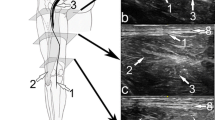Abstract
The piriformis syndrome is an uncommon cause of sciatica, buttock or thigh pain. Because of the deep location of the muscle and sciatic nerve, infiltration has traditionally been guided by electromyography, fluoroscopy, computed tomography or magnetic resonance imaging. The aim of the present study is to describe a simple technique for ultrasound (US)-guided perisciatic infiltration of corticosteroids and anaesthetic using the inferior gluteal artery as a landmark. This technique was used satisfactorily in ten patients. Although the series in the study is limited, the procedure for US-guided infiltration of the perisciatic nerve is a quick, simple, economical and effective technique and can be considered an alternative in the percutaneous treatment of the piriformis syndrome.






Similar content being viewed by others
References
Benzon HT, Katz JA, Benzon HA, Iqbal MS (2003) Piriforme síndrome. Anatomic consderations, a new injection technique, and a review of the literature. Anesthesiolgy 98:1442–1448
Lee EY, Margherita AJ, Gierada DS, Narra VR (2004) MRI of piriforme síndrome. Am J Roentgenol 183:63–64
Parziale JR, Hudgins TH, Fishman LM (1996) The piriformis síndrome. Am J Orthop 25:819–823
Hong CZ, Hsueh TC (1996) Difference in pain relief after trigger point injections in myofascial pain patients with and without fibromyalgia. Arch Phys Med Rehabil 77:1161–1166
Fishman SM, Caneris OA, Bandman TB, Audette JF, Borsook D (1998) Injetions of the piriformis muscle by fluoroscopic and electromyographic guindance. Reg Anesth Pain Med 23:554–559
Hanania M, Kitain E (1998) Perisciatic injection of steroid for the treatment of sciatica due to piriformis syndrome. Reg Anesth Pain Med 23:223–228
Fanucci E, Masala S, Sodani G et al (2001) CT-guided injection of botulinic toxin for percutaneous therapy of piriformis muscle síndrome with preliminary MRI results about denervative process. Eur Radiol 11:2543–2548
Smith J, Hurdle MF, Locketz AJ, Winiewski SJ (2006) Ultrasound-guided piriformis injection: technique description and verification. Arch Phys Med Rehabil 87:1664–1667
Beatty RA (1994)The piriformis muscle syndrome: a simple diagnostic maneuver. Neurosurgery 34:512–514
Durrani Z, Winnie AP (1991) Piriformis muscle syndrome: an underdiagnosed cause of sciatica. J Pain Symptom Manage 6:374–379
Otto R, Deyhle P (1980) Guided puncture under real-time sonographic control. Radiology 134:784–785
Lang AM (2004) Botulinum toxin typo B in piriformis syndrome. Am J Phys Med Rehabil 83:198–202
Papadopoulos EC, Khan SN (2004) Piriformis syndrome and low back pain: a new classification and review of the literature. Orthop Clin N Am 35:65–71
Rodrigue T, Hardy R (2001) Diagnosis and treatment of piriformis syndrome. Nerosurg Clin N Am 12:311–319
Porta M (2000) A comparative trial of botulinum toxin type A and methylprednisolone for the treatment of myofascial pain syndrome and pain from chronic muscle spasm. Pain 85:101–105
Graboski CL, Gray DS, Burnham RS (2005) Botulinum toxin a vesus bupivacaine trigger point injections for the treatment of myofascial pain syndrome: a randomised double blind crossover study. Pain 118:170–175
Filler AG, Haynes J, Sheldon E et al (2005) Sciatica of nondisc origin and piriformis syndrome: diagnosis by magnetic resonance neurography and interventional magnetic resonance imaging with outcome study of resulting treatment. J Neurosurg Spine 2:99–115
Benson ER, Schutzer SF (1999) Porttraumatic piriformis syndrome: diagnosis and results of operative treatment. J Bone Joint Surg Am 81:941–949
Author information
Authors and Affiliations
Corresponding author
Rights and permissions
About this article
Cite this article
Reus, M., de Dios Berná, J., Vázquez, V. et al. Piriformis syndrome: a simple technique for US-guided infiltration of the perisciatic nerve. Preliminary results. Eur Radiol 18, 616–620 (2008). https://doi.org/10.1007/s00330-007-0799-3
Received:
Revised:
Accepted:
Published:
Issue Date:
DOI: https://doi.org/10.1007/s00330-007-0799-3




